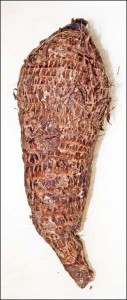Tiquisque Fritos
Tired of French fries? Wondering how to cook those dirty brown tubers you see in all the markets?
In Costa Rica they’re called Tiquisque. Around the world, they belong to a crop as important and widely eaten as rice and potatoes. Although slightly different species, they’re most commonly called Taro, Ñampi, Dasheen, and Cocoyam among other local names. Growing wild or in the garden they’re known as Elephant Ears.

Tiquisque are a good source of fiber, vitamins B6, C, & E, and minerals potassium and manganese among others. However, they also contain Calcium oxalate which is poisonous when raw but rendered harmless when cooked. Calcium oxalate can also be a skin irritant, so wear gloves during preparation if you have sensitive skin.
Tiquisque are available in every food store in Quepos – Manuel Antonio, and probably Costa Rica. When buying them, they must be firm without any soft or rotting spots. The freshest still have purple growing tips at one end. When cut open, they’re creamy white with tiny pink striations in the flesh, and begin immediately to sweat starchy white sap. Green season seems to be the best time to buy Tiquisque because I’ve been seeing some beautiful ones over the last couple of months. During the dry season they’re often dried out, thick skinned, and slightly spongy. An old soft Tiquisque does not make good fritos.
When cooked Tiquisque fritos have a slightly nutty flavour and are a great accompaniment to any grilled meat – steak, chicken, chops, burgers – or can be stored in an airtight container and munched on their own. One of the things about this recipe that I like best is that I can cook them until they’re almost done, then go and finish cooking the rest of the meal, and then complete the last step right before plating, so these are served crispy and everything else is still hot.
Tiquisque Fritos (Serves 2)
Ingredients
1 Tiquisque about 120 grams, 12 cm long, 5 cm at its widest end
Oil for deep frying
Salt to taste
- Pre-heat the deep fryer to exactly 175°C/350°F. If the oil is not hot enough the food will absorb oil and become greasy. If it’s too hot the food will burn. I use a large wok because it gives me a wide surface area to separate the individual pieces and keep them moving. When you drop the fritos in, the oil will foam up a lot so make sure your oil is at least 2 or 3 inches below the top of the pot.
- Wash the Tiquisque well, and pull off as many of the hairy roots as you can. They don’t always have these, but they make peeling more difficult.
- Using a vegetable peeler, peel the Tiquisque. Trim off both ends as necessary. Often the bottom end is too thin and gnarly to use.
- Start slicing. Cut them lengthwise, about 2mm X 2mm & 4 – 5 cm long. You want them to be thin so they cook crispy.
- Divide them into two batches. Lay them out on paper towels and pat dry. They’ll be sticky, but this is an important step because they’ll clump together when frying if you don’t do it.
- When the oil is hot, carefully drop in the first batch. I usually poke around with tongs to break up any clumps that stick together. Fry for 2 minutes or less. Watch carefully, and as soon as the thinnest pieces (usually the ends) begin to brown, remove all to a plate. At this point they won’t be completely cooked, and you don’t need to worry about draining the oil from them.
- Bring the oil back up to the correct temperature, and fry the second batch.
- Dump the 2st batch with the first batch and go finish cooking the rest of your meal. Watch the temperature of your oil. Again, it needs to be 175°C/350°F, so don’t let it overheat.
- When you’re ready to serve, refry both batches together for less than 1 minute until they are stiff and just beginning to change colour. Be careful not to burn them.
- Quickly drain them on paper towels and then toss them with salt. Most of them should be very crunchy and the thickest pieces will be tender on the inside.


Pingback: Road To Upala « at the moment…